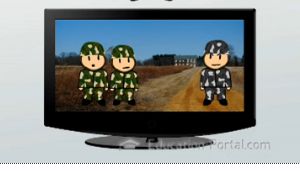Leading as a Function of Management
After you watch the video and know the material, click HERE for the quiz.
This lesson teaches you about leading as a function of management by examining the surprising similarities between two very different leadership scenarios: leadership at war and leadership in the workplace.
Leading as a Function of Management
War is a word that can elicit a variety of feelings based on an individual's knowledge, experience, and belief system. Indeed how a person feels about war will vary greatly from someone who has experienced war firsthand or has lost a loved one to war to an individual who has only read about war in history books or watched news reports about war. Regardless of your position on war, a great deal can be learned by examining how wartime leadership can shape the war's outcome. Most of these principles can be applied to management, and though I doubt many of you would compare your organization to a warzone, you may, however, find a correlation between great leaders on the battlefield and great leaders in the corporate world. To illustrate this idea, this lesson will identify leadership as a function of management by comparing two leaders: Major McCarthy and Manager Mike.
 |
Major McCarthy as a Leader
It is just after 4 a.m. when Major McCarthy and his five troops begin their decent over hostile territory. Rebels have invaded the city of Wannahockalugie and have devastated the town, killing many of the townspeople in the process. Major McCarthy's mission is to parachute in just outside city limits and retake the city. Unfortunately, McCarthy's five troops are fresh out of boot camp, and many of them are uneasy and nervous to even jump out of the plane, let alone to go into a warzone. McCarthy recognizes these fears in his group and knows that he must do something to change those concerns, so they don't have negative effects on the success of the mission.
 |
Manager Mike as a Leader
While Major McCarthy and his troops were jumping out of an airplane, Manager Mike was in New York tackling a leadership scenario of his own. Mike works at Bull's-Eye Mart, a large retail chain where he manages a team of six people. It's three weeks until Christmas and most of Mike's employees have already made plans for how they will spend the holiday with their families. Unfortunately, Manager Mike received an e-mail from his boss this morning informing Mike that vacation requests over the next four weeks will not be honored because of the increase in business they often see during the holiday season. Mike was tasked with delivering this information to his employees.
 |
 |
Manager Mike calls an emergency meeting for all six of his employees. He begins the meeting by thanking his employees for all they do at Bull's-Eye Mart and informs them that he does have some unfortunate news to share. Mike tells his employees about the email and acknowledges that it will be an inconvenience for all of them to be away from their family during the holidays. He even vows to be right by their side during these days, so they can see that he understands and genuinely cares about the burden this has placed on his employees. He can immediately see the sadness come over the faces of his employees. Some of them even begin to cry. He encourages them to share some of their concerns. Mike tells his employees that over the days that they have to work, he will hold contests so that they can earn special prizes and will have meals catered each day. He will also award their vacation requests once the holidays are over and hold a special event for all of their families. He asked the employees to try to accept the situation for what it is and to spread positive messages between each other. Mike also lets his employees know that he is willing to talk to them and even their families if he needs to.
 |
Leading from Combat to Corporate
While Major McCarthy and Manager Mike had two vastly different leadership scenarios, the similarities between them are quite obvious. If you recall, leading as a function of management involves a manager spending time connecting with his or her employees on an interpersonal level. This goes beyond simply managing tasks; rather it involves communicating openly with employees, motivating employees toward higher levels of productivity, inspiring employees to be creative and innovative, and encouraging employees to achieve their goals. Not all managers are leaders. An employee will follow a manager's directions for doing a job because he or she has to, but an employee will voluntarily follow the directions of a leader because he or she believes in who the leader is as a person and in what the leader stands for as well as the manner in which he or she is inspired by the leader.
A successful leader inspires followers, increases morale, and encourages effective communication between employees. If we look back to our examples of Major McCarthy and Manager Mike, we can easily see these characteristics in both of them.
 |
- Inspired his troops by sharing personal stories of his first time in battle and his rate of successful missions. His followers admire what Major McCarthy has done in the past.
- Increased morale by acknowledging the troop's fear and nervousness at which point he told them it was normal but that such feelings needed to be suppressed for the mission to be successful.
- Encouraged communication between troops by detailing how each troop would have one another's back and by explaining how important communication between each of them was to the success of the mission.
Manager Mike did the following:
- Inspired his employees to accept needing to work through the holidays by working alongside them as well as by offering various incentives for their inconvenience.
- Increased morale by, again, offering those incentives, allowing the employees to voice their opinions, and asking that positive messages be communicated to one another.
- Encouraged communication between the employees and him by, again, allowing employees to discuss their feelings and communicate positive messages to one another to avoid breeding negativity around the organization.
Even though Major McCarthy and Manager Mike operated in two different organizations, both were successful leaders. This is because leading as a function of management involves more than just telling others what to do; rather, leadership is about effectiveness through trust, inspiration, and people. Each of these scenarios could have ended much differently had the two groups of people not been lead but managed. Perhaps lives would have been lost in Wannahockalugie, or the staff would have quit at Bull's-Eye Mart; however, fortunately for all of those involved, they were under the direction of a leader.
 |
Lesson Summary
Let's review. This lesson identified leadership as a function of management by comparing two successful leaders from different organizations: Major McCarthy and Manager Mike. Leading as a function of management involves a manager spending time connecting with his or her employees on an interpersonal level. This goes beyond simply managing tasks; rather, it involves communicating openly with employees, motivating employees toward higher levels of productivity, inspiring employees to be creative and innovative, and encouraging employees to achieve their goals. A successful leader inspires followers, increases morale, and encourages effective communication between employees. All of these characteristics were seen in both leadership scenarios presented in this video.
It is important to note that not all managers are leaders. An employee will follow the manager's directions for how to perform a job because he or she has to, but an employee will voluntarily follow the directions of a leader because he or she believes in who the leader is as a person and in what the leader stands for as well as the manner in which he or she is inspired by the leader.